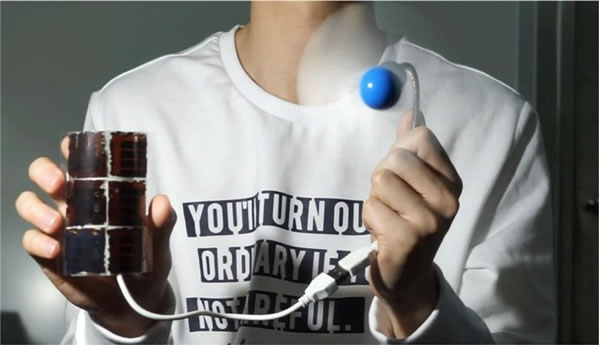"Printing" breaks through the difficulties of flexible perovskite solar cells
On December 29th, 2017, in the Key Laboratory of Green Printing of the Institute of Chemistry, Chinese Academy of Sciences, the researchers showed the reporter of the “Journal of China Science and Technology†their newly prepared perovskite flexible solar cells with a thickness and flexibility comparable to that of a magazine paper. . In the past three years, they have used "printing" to break through the difficulties of flexible perovskite solar cells and are expected to provide reliable power for flexible wearable electronic devices. Recently, this achievement was published in the international academic journal Adv. Mater. In this study, nano-assemblies and printing methods were used to prepare perovskite honeycomb nano-scaffolds, and “optical resonant cavities†were built in them. These two innovations also improved the mechanical stability and optoelectronics of flexible perovskite solar cells. Conversion rate. New Application of Perovskite Materials "If the smart watch can be equipped with a strap for solar power generation, there is no need to charge it every day." Talking about the original intention of carrying out the study, the first author of the paper, Hu Xiaotian, a doctoral student at the Institute of Chemistry, Chinese Academy of Sciences stated. The exponential growth of the perovskite efficiency of power generation and the accumulation of technology for ink-jet printing of perovskite single-crystal materials led him to see this idea achievable. Perovskite has high photoelectric conversion efficiency and low price and is a good solar cell material. When many laboratories were working hard on how to replace perovskite with silicon, Song Yanlin's group saw another direction of application—flexible solar power. Researchers are "loving and hating" perovskites. They are thin and their substrate thickness is within one millimeter. They may be worn on the human body. However, they are brittle and not resistant to bending. In order to increase the bending, Hu Xiaotian tried to use soft materials to wrap the perovskites up and down. The results were not satisfactory. In the end, he was inspired by nature's honeycomb structure with the most stable mechanical structure. The nano-assembly-printing method to prepare a honeycomb-like nano-scaffold can be used as a mechanical buffer layer to achieve higher mechanical stability of flexible perovskite solar cells. At the same time, the photoelectric conversion rate of the perovskite battery is also one of the problems to be solved. Due to technical limitations, the larger the area of ​​the perovskite film, the lower the photoelectric conversion rate. Hu Xiaotian built an optical resonant cavity inside the device, achieving a photoelectric conversion rate of 12.32% over an area of ​​50 square centimeters, and achieved a major breakthrough in high-efficiency battery reproducibility over a large area. Printing preparation provides technical accumulation In fact, Song Yanlin's research group could overcome the perovskite's nature and make a breakthrough without the accumulation of their technology in green printing. Different from the printing content of traditional graphic materials, Song Yanlin's research group proposed the concept of “big printingâ€, which can print various functional materials on the substrate through printing. Today, researchers' "printing skills" are accurate to the nanometer level and can print out "the finest line" and "the smallest point." Last year, the laboratory also successfully created wearable sensors that can recognize complex expressions and are expected to be used in areas such as pulse monitoring, cardiac monitoring, and remote manipulation. "Perovskite cells are prepared by printing perovskite monocrystalline materials onto substrates by ink jet printing," said Song Yanlin. Not only that, the honeycomb nano-scaffold used to improve the bending properties was also prepared by printing: “We used ink printing to assemble honeycomb-sized balls into a single-layer, closely-arranged form, and then filled the honeycomb with balls and balls. In the middle, the ball is washed out again, forming a honeycomb net." Large areas of flexible materials can be expected in the future Three years, more than 2,000 devices, is Song Yanlin led the task force in this study. “Seasonal changes in humidity have a large impact on the success rate of the experiment. Like luck, each step is very careful and serious, but the final device performance is not good.†Song Yanlin recalls. During the three years of project research, Hu Xiaotian and members of the research team had to do at least three samples each day to test the values. Hu Xiaotian used tweezers to pick up a glass plate about the size of a fingernail. A dark brown perovskite solar cell was embedded in it. “This is the research direction of most of the current laboratories. It achieves a large photoelectric conversion rate in a very small area. The conversion rate of this material is about 20%, but the area is too small and the power generation is only a few milliwatts. The value is not enough." Song Yanlin said that scientific research must be applied to applications. Perovskite solar cells cannot blindly pursue high conversion rates while ignoring usability. At present, the research focus of the laboratory is still on a large area and flexible, and the results of a larger area and more easily bent perovskite battery are expected to be released next year. Although there are still many problems with perovskite solar cells out of the laboratory, researchers are still optimistic about their future applications. In addition to wearable devices, in the future, perovskite batteries may also be used in clothing, automotive glass and other places to absorb sunlight and convert electricity into other devices, which is both environmentally friendly and practical. White Delrin Rod,Pom Bar Original,White Acetal Rod,Natural Delrin Rod Ningbo Zero Engineering Plastics Co.,Ltd , https://www.zero-peek.com
Newly-developed perovskite flexible solar cells drive fans to rotate (photo courtesy of the Institute of Chemistry, Chinese Academy of Sciences)
